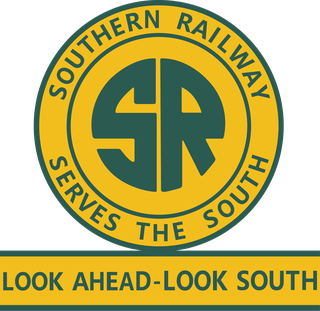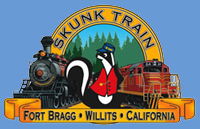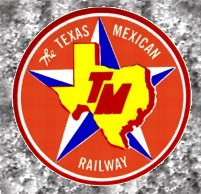
The Southern Railway was a class 1 railroad based in the Southern United States between 1894 and 1982, when it merged with the Norfolk and Western Railway (N&W) to form the Norfolk Southern Railway. The railroad was the product of nearly 150 predecessor lines that were combined, reorganized and recombined beginning in the 1830s, formally becoming the Southern Railway in 1894.

The Pennsylvania-Reading Seashore Lines was a railroad that operated in South Jersey in the 20th century. It was created in 1933 as a joint consolidation venture between two competing railroads in the region: the Pennsylvania Railroad and the Reading Company.

The California Western Railroad, AKA Mendocino Railway popularly called the Skunk Train, is a rail freight and heritage railroad transport railway in Mendocino County, California, United States, running from the railroad's headquarters in the coastal town of Fort Bragg to the interchange with the Northwestern Pacific Railroad at Willits.

The Roaring Camp & Big Trees Narrow Gauge Railroad is a 3 ft narrow-gauge tourist railroad in California that starts from the Roaring Camp depot in Felton, California and runs up steep grades through redwood forests to the top of nearby Bear Mountain, a distance of 3.25 miles.

The Prescott and Northwestern Railroad is a short-line railroad headquartered in Prescott, Arkansas. It is operated by Arkansas Midland Railroad, which is owned by Genesee & Wyoming.

The Sumpter Valley Railway, or Sumpter Valley Railroad, is a 3 ft narrow gauge heritage railroad located in Baker County, in the U.S. state of Oregon. Built on a right-of-way used by the original railway of the same name, it carries excursion trains on a roughly 5-mile (8.0 km) route between McEwen and Sumpter. The railroad has two steam locomotives and several other pieces of rolling stock. Passenger excursion trains operate on weekends and holidays from Memorial Day through the end of September.

The Texas Mexican Railway was a short line railroad in the U.S. state of Texas operating between Corpus Christi and the Texas Mexican Railway International Bridge in Laredo, Texas. It is often referred to as the Tex-Mex, or TexMex Railway.

The McCloud Railway was a class III railroad operated around Mount Shasta, California. It began operations on July 1, 1992, when it took over operations from the McCloud River Railroad. The MCR was incorporated on April 21, 1992.

The Oregon, Pacific and Eastern Railway was an Oregon-based short line railroad that began near Eugene as the Oregon and Southeastern Railroad (O&SE) in 1904. O&SE's line ran 18 miles (29 km) along the Row River between the towns of Cottage Grove and Disston. The Oregon, Pacific & Eastern Railway Company incorporated in 1912, purchased the physical assets of the O&SE two years later, and shortened their total trackage to operate 16.6 miles (26.7 km) from an interchange yard with the Southern Pacific Railroad at Cottage Grove, east to a 528' x 156' turnaround loop at Culp Creek. The last of this track was closed and scrapped in 1994, and ownership of its abandoned right of way property was later reverted to the state of Oregon to become one of the first-ever Government/Private Sector cooperative partnership Rails to Trails programs in the US, forming the Row River National Recreation Trail. A successor corporation now operates a narrow-gauge line at Wildlife Safari.

The Belvidere & Delaware River Railway Company also known as Delaware River Railroad is a class III railroad in the United States. It was formed in 1995 when the Conrail Delaware Secondary line was purchased by the Black River Railroad System, which operates several railroad services in western New Jersey and eastern Pennsylvania. The Black River Railroad System also owns and operates the Black River & Western Railroad (BR&W). BR&W leases 10 miles of track to BDRV since 2004. Trackage purchased was a segment of the original Belvidere Delaware Railroad, later controlled by the Pennsylvania Railroad and ultimately Penn Central.
The 5-mile (8.0 km) Reader Railroad was a tourist-only railroad operating in Hot Springs, Arkansas from 1973 to 1991. As a 23-mile (37 km) common carrier prior to May 1973, it was the last all steam locomotive-powered, mixed train railroad operating in North America. It operated trackage in Ouachita County and Nevada County, Arkansas. The five mile tourist railroad operated until 1991, when it could not meet the new federal safety regulations.

The Oregon Railroad and Navigation Company (OR&N) was a railroad that operated a rail network of 1,143 miles (1,839 km) running east from Portland, Oregon, United States, to northeastern Oregon, northeastern Washington, and northern Idaho. It operated from 1896 as a consolidation of several smaller railroads.

The Texas Transportation Museum (TTM) is a transportation museum located in San Antonio, Texas.
Pickens Railway is a shortline railroad that has operated on two separate divisions in the Upstate Region of South Carolina:
Camden is an unincorporated community in east central Polk County, Texas, United States. It is located at the junction of Farm to Market Roads 942 and 62, eighty miles north-northwest of Beaumont. As of the year 2000, the community had approximately 1,200 residents.

The Tacoma Eastern Railroad was officially established by John F. Hart and George E. Hart in 1891. The enterprising lumberman received leases from Pierce County to harvest lumber from sections of a local school district. By 1890, most available timber near navigable water had been harvested. Sawmill industries had traditionally used the Puget Sound to float their wares to schooner captains, which can then be transported to markets, typically in San Francisco. To accommodate this new dilemma, the J.F Hart and Company began planning and construction for the Tacoma Eastern Railroad

The Minarets and Western Railway was a Class II common carrier that operated in Fresno County, California, from 1921 to 1933. The railway was owned by the Sugar Pine Lumber Company and was built the same year the lumber company was incorporated so that it could haul timber from the forest near Minarets to its sawmill at Pinedale. The southern portion of the line was operated with joint trackage rights with Southern Pacific.
Southern Pacific Transportation Company formed the Oregon and Eureka Railroad Company in 1903 in an agreement to use logging railroads as part of a line connecting Humboldt County (California) sawmills with the national rail network. Northwestern Pacific Railroad offered service over the route from 1911 through 1933. The northern 6-mile (9.7 km) of the line remained in use as a Hammond Lumber Company logging branch until 1948.












